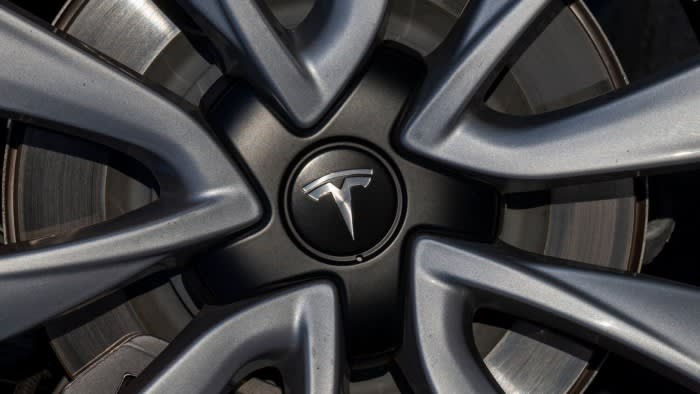Unlock the Editor’s Digest for free
Roula Khalaf, Editor of the FT, selects her favourite stories in this weekly newsletter.
Tesla’s shares surged on Wednesday after the world’s largest electric vehicle maker reported higher than expected quarterly profit, while forecasting “slight growth” in deliveries this year and a big jump in 2025.
The performance marks a turnaround for Tesla, which has endured a few disappointing quarters as concern spread about slowing global demand for EVs. It has also been caught up in the divisive political activism of its chief executive, Elon Musk, and a court battle to restore his $56bn package of share options.
Musk predicted vehicle sales could grow 20 per cent to 30 per cent next year after cost cuts reduce the prices of existing cars which in turn would spur demand.
He also cited improvements to the self-driving technology and new products including its autonomous “Cybercab” unveiled earlier this month. Musk also said lower interest rates were reducing monthly financing payments that was having a meaningful impact on demand.
Tesla’s shares rose 12 per cent in after-hours trading, providing some relief to investors — they are half their November 2021 peak. It is still the most valuable global carmaker at $669bn.
Adjusted net income for third quarter rose 8 per cent from a year ago to $2.5bn, exceeding expectations for $2.1bn, according to a filing from the Austin, Texas-based company. Revenue rose 8 per cent to $25.2bn, slightly undershooting the average $25.4bn estimate by analysts.
Profit was driven by a 2 per cent increase in revenue from vehicle sales — which contributes four-fifths of group income — alongside a 52 per cent jump at its energy generation and storage business and 29 per cent increase its services arm, which includes its supercharger network.
Operating expenses fell 6 per cent to $2.3bn after it cut a tenth of its workforce, about 14,000 jobs, earlier this year.
“Despite ongoing macroeconomic conditions, we expect to achieve slight growth in vehicle deliveries in 2024,” Tesla said. “Plans for new vehicles, including more affordable models, remain on track for start of production in the first half of 2025.”
However, Musk said Tesla was not developing a much-anticipated affordable $25,000 “Model 2”.
“We are not making a non-robotaxi model . . . Having a regular [$25,000] model is pointless, it is completely irrelevant considering what we believe,” he said.
“This is blindingly obvious at this point, that [autonomy] is the future,” he added.
Instead, Musk said Tesla was focused on reducing the cost of existing models. Its Cybercab would cost roughly $25,000, when government EV incentives are deducted.
Musk has made a strategic pivot towards autonomous driving, artificial intelligence and robotics, predicting these technologies would soon be Tesla’s main revenue sources and drive up its valuation. He recently unveiled a prototype for a new fleet of self-driving “Cybercabs” that he hopes to have in production before the start of 2027.
However, a lack of engineering or financial details in the splashy “We, Robot” event — held at a movie studio in Los Angeles, where Tesla’s “Optimus” humanoid robots danced to Daft Punk and served beer to attendees — disappointed analysts and investors and the stock fell 9 per cent in the aftermath.
Data for the third quarter provided more optimism. Tesla said Cybertruck production reported a positive gross margin for the first time — after years of production delays and recalls — and was the third best-selling EV in the US behind its Model Y and Model 3. The company added its “Semi” electric truck factory would start production by the end of next year, for which Musk said there was “ridiculous demand”.
Earlier this month, Tesla reported deliveries rose 6.4 per cent in the third quarter to 462,890 vehicles globally, buoyed by Chinese sales that offset weak demand in Europe. It retained its position as the top EV maker ahead of China’s BYD.
Analysts on Wednesday also flagged an improvement to Tesla’s gross margin, which widened to 19.8 per cent in the quarter from 17.9 per cent in the same period last year.
The closely watched financial metric was flattered by $739mn of revenue from regulatory credits, which it sells to other manufacturers that do not meet EV production-related emissions targets. That was its second highest ever after the record $890mn in the second quarter.
Tesla also provided an update on the number of Nvidia H100 graphics processing unit chips installed at its Texas manufacturing plant used to train the AI systems that underpin its self-driving technology, called FSD. It said 29,000 were installed in a cluster at the Gigafactory and this would increase to 50,000 by the end of October.
Musk has courted controversy for his robust backing of Republican presidential candidate Donald Trump. He is giving away $1mn a day to registered voters in swing states who sign a petition backing free speech and the right to bear arms.
In return, Trump has pledged to make Musk head of a “department of government efficiency” that would make suggestions for cutting spending, bureaucracy and regulations, a position that could benefit his other companies including SpaceX and social media network X. However, those political activities risk provoking the ire of Democratic candidate Kamala Harris should she win.

